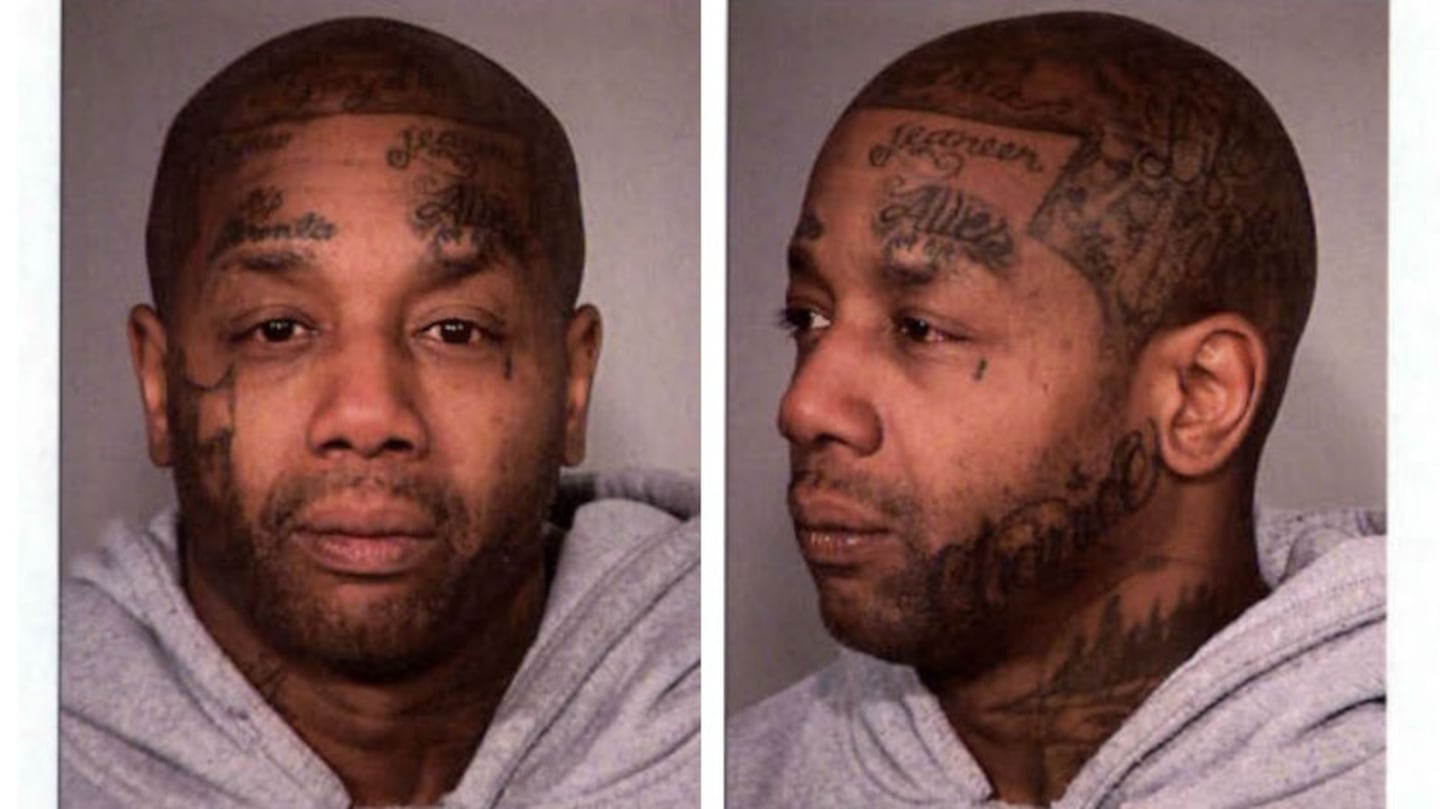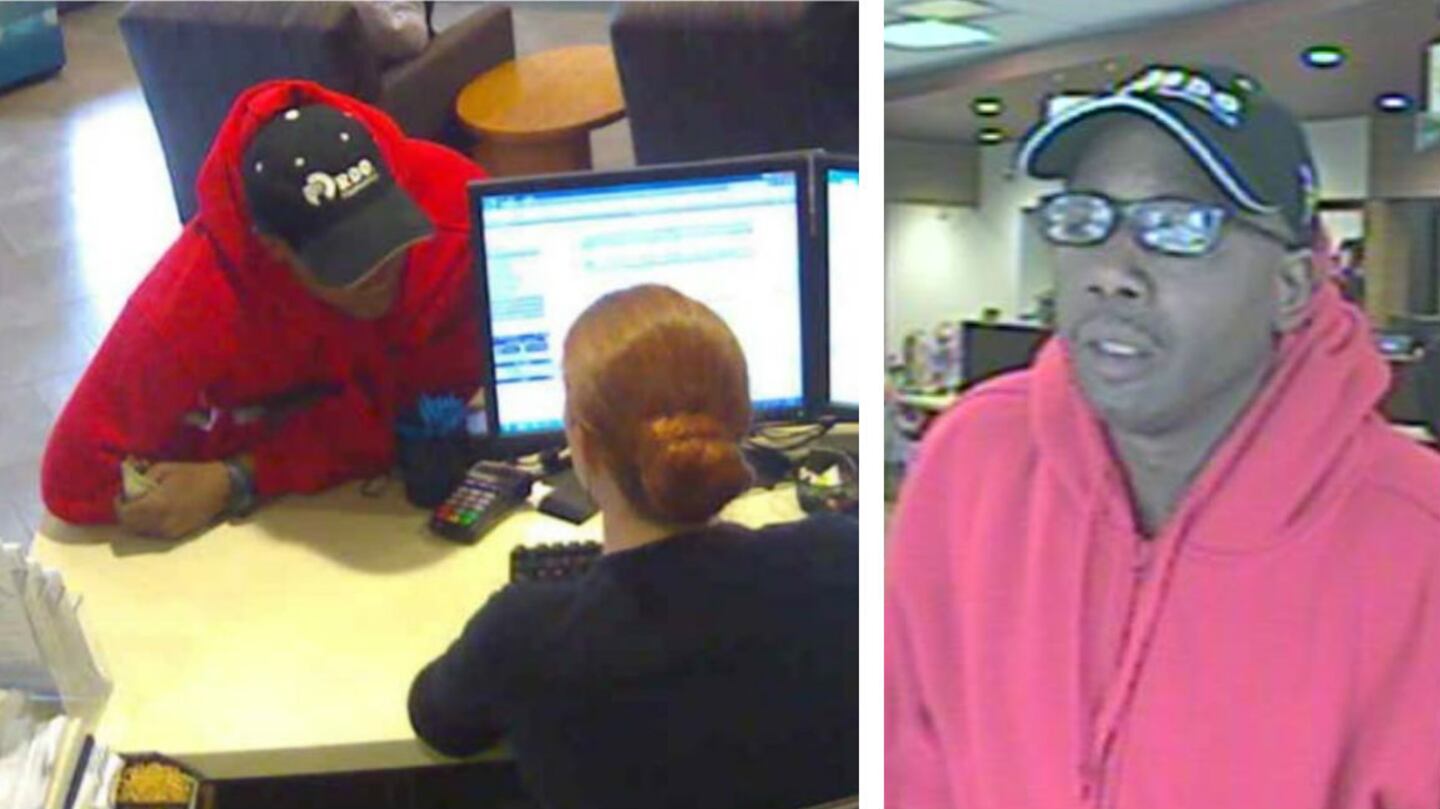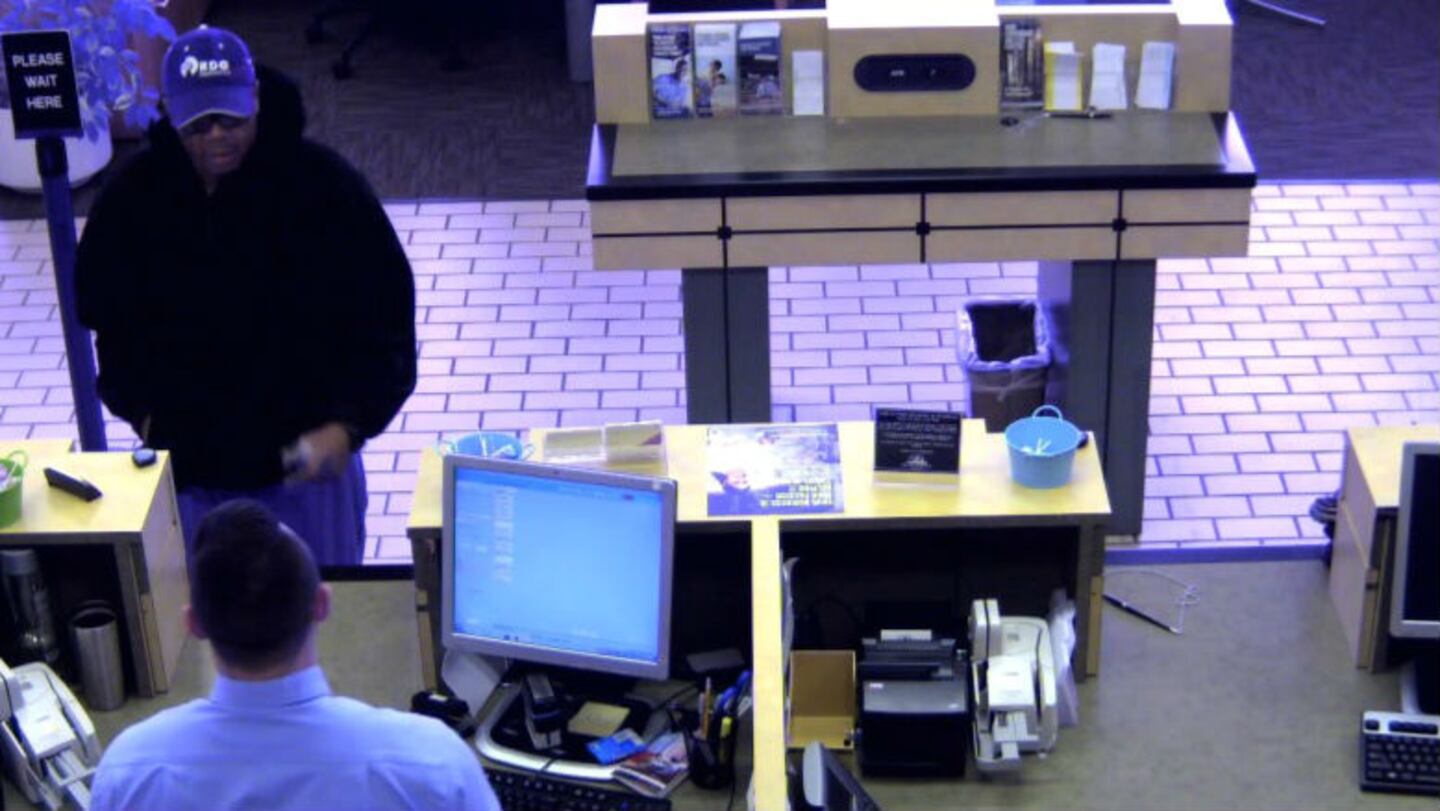PORTLAND, Ore. — Police were searching for the man they dubbed the "Foul Mouth Bandit."
Detectives in Portland, Oregon, were trying to identify the man responsible for four bank and credit union robberies and the robbery of a bar in April 2017 when the name Tyrone Lamont Allen came across their radar. There was a problem with Allen as the suspect, however.
Allen, 50, has multiple elaborate, prominent tattoos on his forehead, cheeks and neck, as seen in April 18, 2017, booking photos shot following his arrest on unrelated warrants. The tattoos include several clearly readable names on his forehead.
Only two of the four bank tellers who encountered the robber earlier that month recalled seeing tattoos, court records show. One mentioned tattoos on the man's hands and the other mentioned faded tattoos on the man's neck.
None of the four witnesses noted tattoos on the robber's forehead or cheeks, which according to surveillance images of the man, were clearly visible -- and clearly bare of ink.
A police forensic criminalist testified last week about how investigators solved the problem. They turned to Photoshop.
"I basically painted over the tattoos,'' Mark Weber testified, according to The Oregonian. "Almost like applying electronic makeup."
Only then did investigators present Allen's photo to the witnesses in a photo lineup, the newspaper reported. None of the witnesses were told the photos had been altered -- which the newspaper reported is a violation of U.S. Department of Justice and other law enforcement agencies' protocols on how to handle photo lineups.
According to court records, two of the four witnesses picked Allen out of the array. One said he did not see the robber in the six photos he was shown and another picked a different man's photo.
Allen was subsequently charged with three counts of robbery and one count of attempted robbery. Because the targets were banks and credit unions, he is charged with federal crimes.
The Innocence Project, an organization dedicated to helping exonerate wrongly convicted inmates, reports that mistaken witness identifications have contributed to about 71 percent of the more than 360 wrongful convictions in the U.S. overturned by post-conviction DNA analysis.
Allen's defense attorney, who last month filed a motion asking a judge to suppress the witness identifications at trial, argued in federal court last week that the police were trying to "rig the outcome" of the lineups by making his client look more like the man who robbed the banks and credit unions, The Oregonian reported.
"This is a very, very slippery slope given the advent of technology,'' attorney Mark Ahlemeyer said. "We don't know where this may end."
The prosecutor in the case, Assistant U.S. Attorney Paul Maloney, defended the actions of police.
"The whole idea was to make Mr. Allen blend in so his photo wouldn't stand out,'' Maloney argued, according to the newspaper. "These procedures were prudent. They were appropriate.''
Maloney said the mugshot was altered to make Allen's photo look like the disguises the robber wore, The Oregonian said.
The affidavit of Brett Hawkinson, the Portland Police Bureau detective on the robbery case, states that investigators found several items of clothing in Allen's 1998 Dodge Intrepid that looked similar to items worn by the robber depicted in surveillance footage from the crime scenes.
Nowhere does Hawkinson say authorities found makeup or other tools Allen may have used to cover up his facial tattoos.
Hawkinson noted the absence of the tattoos when he first looked at Allen's booking photos and compared them to the surveillance images, his affidavit says.
"The robber and Allen looked like the same person, minus the presence of Allen's facial tattoos," Hawkinson wrote.
Nevertheless, after meeting with Allen in person at the Multnomah County Jail, Hawkinson wrote that he was certain Allen was his suspect.
"After having the chance to see Allen in person and interact with him close up, I have no doubt in my mind that he is the same person depicted in the surveillance images as the robbery suspect from the OnPoint Community Credit Union, Wells Fargo Bank, Bank of the West and Advantis Credit Union robberies as described above," Hawkinson's affidavit states.
Three days after that meeting, on May 20, Hawkinson released images from the bank robberies to the public in an effort to identify the "Foul Mouth Bandit," who got the name from the language he used while holding up the tellers.
Read Allen's motion to suppress the witness identifications below.
Tyrone Lamont Allen Motion to Suppress by National Content Desk on Scribd
According to the charges against Allen, he is accused of going to OnPoint Credit Union in Portland the afternoon of April 3, 2017, and approaching a teller. The alleged robber handed the teller a $20 and asked for change, a pattern that later emerged in other robberies, as well.
As the teller chatted with the man, the man leaned forward and opened a white plastic shopping bag.
"Give me your (expletive) money! I have a gun! I will blow your head off," the man said, according to court documents.
The robber got away with about $6,000 that day. Similar robberies, in which the surveillance footage from each appeared to show the same man, took place the following day at a Wells Fargo branch and on April 7, 2017, an attempted robbery at Bank of the West and a successful robbery at Advantis Credit Union.
In total, the man walked away with about $14,000 from the four robberies, court records show.
According to Hawkinson's affidavit, the teller in the first incident noticed tattoos on the robber's hands. The Wells Fargo teller told detectives the man in that case had faded tattoos on his neck.
There is no mention of any tattoos on the robber in either the Bank of the West or Advantis Credit Union heist. In none of the bank or credit union robberies did witnesses see a weapon.
During the investigation, Hawkinson spoke with another Portland detective who was working a separate series of armed robberies in north Portland. The suspect in that case, a black man with tattoos, went to a Subway, a Papa Murphy's pizza shop, a Walgreens and a 7-Eleven and robbed each using a semi-automatic pistol. The detective, William Winters, was also investigating the robbery of Sting Tavern in Portland.
Winters told Hawkinson the video surveillance from the tavern showed the robber wearing a red sweatshirt similar to the one worn by the man who robbed the Advantis Credit Union. The weight, height and build of each robber was also similar.
Winters led Hawkinson to an unnamed informant who came forward and told police about a person he suspected in a series of robberies. That person was Allen.
The man, identified only as the "known person" in court records, told investigators that he met Allen through a mutual friend, who showed him Allen's April 18, 2017, mugshot alongside the robbery surveillance images later broadcast on the TV news. He said both he and the mutual friend suspected it was Allen, who they said had a violent past.
"When asked how he knew the surveillance picture on Channel 12 was Allen, the known person stated he did not know, but then he immediately changed his statement and said he knew it was Allen because it looked just like him except for no tattoos."
Hawkinson wrote that the victim in the OnPoint Community Credit Union robbery was shown a photo lineup including Allen's photo, but said he did not see the man who robbed him. The same day, the Bank of the West victim picked a different photo from the array, but said she was unsure of her selection.
The victim from Advantis Credit Union picked Allen's photo that same day, as did the Wells Fargo victim the following day, May 3.
Ahlemeyer's motion to suppress the identifications of his client argue that none of the police reports document now the lineups were put together. Nowhere does Hawkinson's affidavit mention that Allen's mugshot was altered prior to it being shown to the witnesses.
"The novel question in this case is whether the government can materially alter a suspect's photograph in a way that makes him look more like the perpetrator, then secure an eyewitness identification based on that manipulated photo, and ultimately present that positive identification to a jury," Ahlemeyer's motion states. "The court should reject this type of fabricated evidence either as a violation of due process or under the court's inherent supervisory power to ensure the integrity of the judicial process."
The defense attorney also argues that the identifications were "unconstitutionally suggestive" and, therefore, unreliable.
"The Fifth Amendment right to due process bars the introduction of identification evidence where it was procured or tainted by unnecessarily suggestive law enforcement procedures that created a substantial likelihood of misidentification," the motion states.
The Oregonian reported that it was Ahlemeyer who first discovered his client's mugshot had been altered. Though no police reports referenced the change, Ahlemeyer spotted the anomaly in the photo array after it was handed over as part of the discovery process.
Testimony in court last week showed the order to remove the tattoos from Allen's mugshot came from Hawkinson, an 18-year police veteran assigned to the FBI's task force on bank heists. It was in that role that he was assigned the case.
Hawkinson testified that Allen could have worn makeup during the robberies to mask the tattoos. According to The Oregonian, he said he sought to rule Allen in or out as the suspect and to determine if people who contacted investigators with information were credible.
Read the criminal complaint against Tyrone Allen below. Warning: The document contains graphic language.
Tyrone Lamont Allen Criminal Complaint by National Content Desk on Scribd
Hawkinson also testified that the victims were shown the photos in a double-blind lineup -- a lineup in which an officer unaware of who the suspect might be shows the photos to a witness one at a time. The technique is a way to help ensure a lack of suggestibility on the part of investigators.
The double-blind lineup is one of a number of reforms the Innocence Project has endorsed to help improve eyewitness accuracy. Oregon is one of 24 states that have implemented those reforms.
Finding ways for the suspect to not stand out from the "fillers," or the people whose photos are shown alongside that the of the suspect, is another. Prosecutor Maloney argued last week that the tattoos were removed from Allen's photo for that purpose.
The Oregonian reported that Justice Department rules adopted in January 2017, just a few months before Allen's arrest, suggest finding "filler" photos of people with attributes similar to those of the suspect. If the unique attribute cannot be replicated, investigators should black out the attribute and put similar black marks on the filler photos.
On cross-examination, Hawkinson admitted that altering a suspect's photo is not part of the bureau's protocol, but said it is "standard practice among investigators," the newspaper reported.
"The purpose of any alteration is not to change the physical attributes but to mask things that would stand out," Hawkinson said.
"You don't consider tattoos to be physical attributes?'' Ahlemeyer asked.
Weber, the forensic criminalist, told the court he did not write a report about the alterations he made to the photo because it wasn't part of the bureau's operating procedures. He admitted that he's changed suspects' photos in connection with past investigations.
"It is hard to fathom any photo array conduct that is more 'suggestive' than altering a source photograph for the sole purpose of making the investigation target look more like the perpetrator," Allen's attorney told the court.
U.S. District Judge Marco A. Hernandez told parties in the case he would issue his written ruling soon, The Oregonian reported.
Cox Media Group












